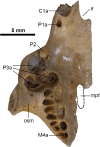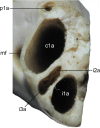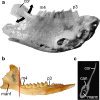The Skull of Epidolops ameghinoi from the Early Eocene Itaboraí Fauna, Southeastern Brazil, and the Affinities of the Extinct Marsupialiform Order Polydolopimorphia
- PMID: 29187780
- PMCID: PMC5684316
- DOI: 10.1007/s10914-016-9357-6
The Skull of Epidolops ameghinoi from the Early Eocene Itaboraí Fauna, Southeastern Brazil, and the Affinities of the Extinct Marsupialiform Order Polydolopimorphia
Abstract
The skull of the polydolopimorphian marsupialiform Epidolops ameghinoi is described in detail for the first time, based on a single well-preserved cranium and associated left and right dentaries plus additional craniodental fragments, all from the early Eocene (53-50 million year old) Itaboraí fauna in southeastern Brazil. Notable craniodental features of E. ameghinoi include absence of a masseteric process, very small maxillopalatine fenestrae, a prominent pterygoid fossa enclosed laterally by a prominent ectopterygoid crest, an absent or tiny transverse canal foramen, a simple, planar glenoid fossa, and a postglenoid foramen that is immediately posterior to the postglenoid process. Most strikingly, the floor of the hypotympanic sinus was apparently unossified, a feature found in several stem marsupials but absent in all known crown marsupials. "Type II" marsupialiform petrosals previously described from Itaboraí plausibly belong to E. ameghinoi; in published phylogenetic analyses, these petrosals fell outside (crown-clade) Marsupialia. "IMG VII" tarsals previously referred to E. ameghinoi do not share obvious synapomorphies with any crown marsupial clade, nor do they resemble those of the only other putative polydolopimorphians represented by tarsal remains, namely the argyrolagids. Most studies have placed Polydolopimorphia within Marsupialia, related to either Paucituberculata, or to Microbiotheria and Diprotodontia. However, diprotodonty almost certainly evolved independently in polydolopimorphians, paucituberculatans and diprotodontians, and Epidolops does not share obvious synapomorphies with any marsupial order. Epidolops is dentally specialized, but several morphological features appear to be more plesiomorphic than any crown marsupial. It seems likely Epidolops that falls outside Marsupialia, as do morphologically similar forms such as Bonapartherium and polydolopids. Argyrolagids differ markedly in their known morphology from Epidolops but share some potential apomorphies with paucituberculatans. It is proposed that Polydolopimorphia as currently recognised is polyphyletic, and that argyrolagids (and possibly other taxa currently included in Argyrolagoidea, such as groeberiids and patagoniids) are members of Paucituberculata. This hypothesis is supported by Bayesian non-clock phylogenetic analyses of a total evidence matrix comprising DNA sequence data from five nuclear protein-coding genes, indels, retroposon insertions, and morphological characters: Epidolops falls outside Marsupialia, whereas argyrolagids form a clade with the paucituberculatans Caenolestes and Palaeothentes, regardless of whether the Type II petrosals and IMG VII tarsals are used to score characters for Epidolops or not. There is no clear evidence for the presence of crown marsupials at Itaboraí, and it is possible that the origin and early evolution of Marsupialia was restricted to the "Austral Kingdom" (southern South America, Antarctica, and Australia).
Keywords: Argyrolagidae; Eocene; Epidolops; Itaboraí; Marsupialia; Marsupialiformes; Polydolopimorphia.
Figures














Similar articles
-
Skeleton of an unusual, cat-sized marsupial relative (Metatheria: Marsupialiformes) from the middle Eocene (Lutetian: 44-43 million years ago) of Turkey.PLoS One. 2017 Aug 16;12(8):e0181712. doi: 10.1371/journal.pone.0181712. eCollection 2017. PLoS One. 2017. PMID: 28813431 Free PMC article.
-
An 'ameridelphian' marsupial from the early Eocene of Australia supports a complex model of Southern Hemisphere marsupial biogeography.Naturwissenschaften. 2012 Sep;99(9):715-29. doi: 10.1007/s00114-012-0953-x. Epub 2012 Aug 5. Naturwissenschaften. 2012. PMID: 22864962
-
The origin of the Australasian marsupial fauna and the phylogenetic affinities of the enigmatic monito del monte and marsupial mole.Proc Biol Sci. 1998 Dec 22;265(1413):2381-6. doi: 10.1098/rspb.1998.0587. Proc Biol Sci. 1998. PMID: 9921677 Free PMC article.
-
A new protodidelphid (Mammalia, Marsupialia, Didelphimorphia) from the Itaboraí Basin and its implications for the evolution of the Protodidelphidae.An Acad Bras Cienc. 2019;91Suppl 2(Suppl 2):e20180440. doi: 10.1590/0001-3765201820180440. Epub 2018 Oct 18. An Acad Bras Cienc. 2019. PMID: 30365721
-
Australasian marsupials--to cherish and to hold.Reprod Fertil Dev. 2001;13(7-8):477-85. doi: 10.1071/rd01079. Reprod Fertil Dev. 2001. PMID: 11999297 Review.
Cited by
-
A probable koala from the Oligocene of central Australia provides insights into early diprotodontian evolution.Sci Rep. 2023 Sep 4;13(1):14521. doi: 10.1038/s41598-023-41471-0. Sci Rep. 2023. PMID: 37666885 Free PMC article.
-
New radiometric 40Ar-39Ar dates and faunistic analyses refine evolutionary dynamics of Neogene vertebrate assemblages in southern South America.Sci Rep. 2021 May 10;11(1):9830. doi: 10.1038/s41598-021-89135-1. Sci Rep. 2021. PMID: 33972595 Free PMC article.
-
On the development of the chondrocranium and the histological anatomy of the head in perinatal stages of marsupial mammals.Zoological Lett. 2017 Feb 12;3:1. doi: 10.1186/s40851-017-0062-y. eCollection 2017. Zoological Lett. 2017. PMID: 28203388 Free PMC article. Review.
-
Total evidence phylogeny and evolutionary timescale for Australian faunivorous marsupials (Dasyuromorphia).BMC Evol Biol. 2017 Dec 4;17(1):240. doi: 10.1186/s12862-017-1090-0. BMC Evol Biol. 2017. PMID: 29202687 Free PMC article.
-
Skeleton of an unusual, cat-sized marsupial relative (Metatheria: Marsupialiformes) from the middle Eocene (Lutetian: 44-43 million years ago) of Turkey.PLoS One. 2017 Aug 16;12(8):e0181712. doi: 10.1371/journal.pone.0181712. eCollection 2017. PLoS One. 2017. PMID: 28813431 Free PMC article.
References
-
- Abbie AA. A masticatory adaptation peculiar to some diprotodont marsupials. Proc Zool Soc Lond. 1939;B109(2):261–279.
-
- Abello MA. Analysis of dental homologies and phylogeny of Paucituberculata (Mammalia: Marsupialia) Biol J Linn Soc. 2013;109(2):441–465.
-
- Abello MA, Candela AM. Postcranial skeleton of the Miocene marsupial Palaeothentes (Paucituberculata, Palaeothentidae): paleobiology and phylogeny. J Vertebr Paleontol. 2010;30(5):1515–1527.
-
- Abello MA, Rubilar-Rogers D. Revisión del género Abderites Ameghino, 1887 (Marsupialia, Paucituberculata) Ameghiniana. 2012;48(3):605–620.
-
- Ameghino F. Notices préliminaires sur les mammifères nouveaux des terrains crétacés de Patagonie. Boletín de la Academia Nacional de Ciencias de Córdoba. 1902;17:5–70.
LinkOut - more resources
Full Text Sources
Other Literature Sources
